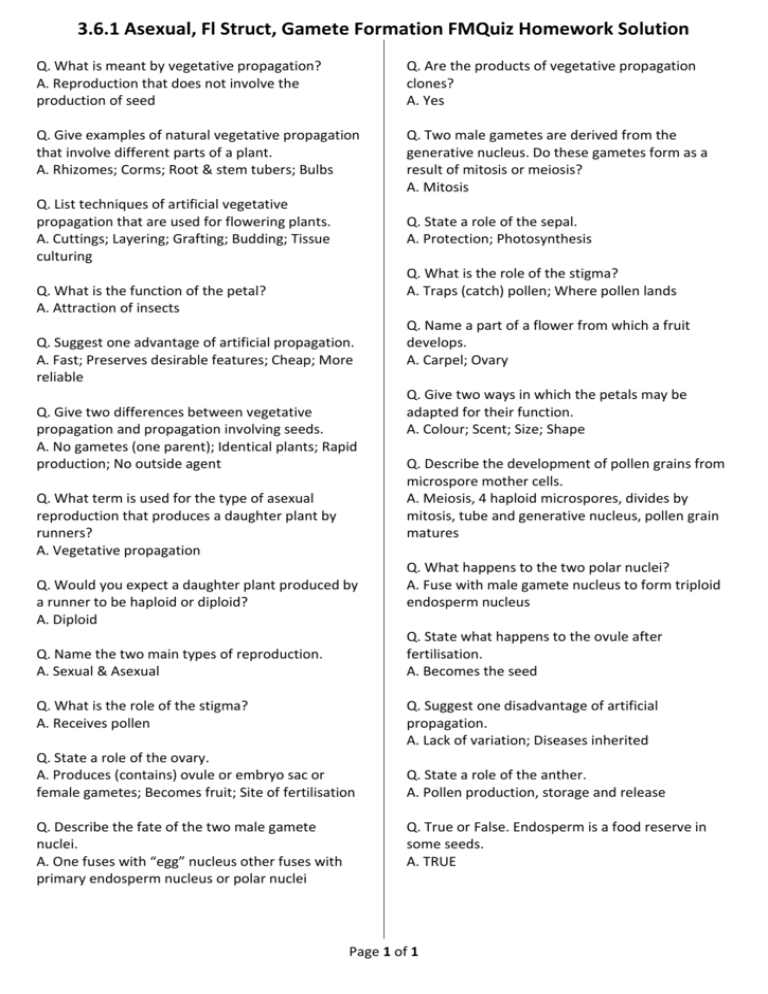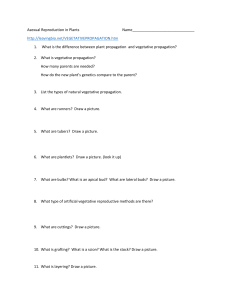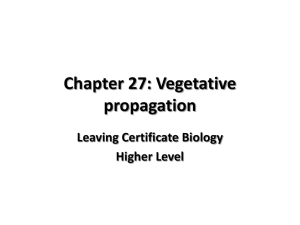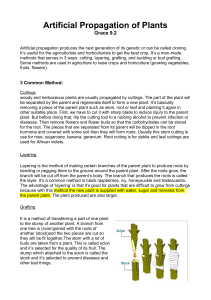Q. What is meant by vegetative propagation?
advertisement

3.6.1 Asexual, Fl Struct, Gamete Formation FMQuiz Homework Solution Q. What is meant by vegetative propagation? A. Reproduction that does not involve the production of seed Q. Are the products of vegetative propagation clones? A. Yes Q. Give examples of natural vegetative propagation that involve different parts of a plant. A. Rhizomes; Corms; Root & stem tubers; Bulbs Q. Two male gametes are derived from the generative nucleus. Do these gametes form as a result of mitosis or meiosis? A. Mitosis Q. List techniques of artificial vegetative propagation that are used for flowering plants. A. Cuttings; Layering; Grafting; Budding; Tissue culturing Q. State a role of the sepal. A. Protection; Photosynthesis Q. What is the role of the stigma? A. Traps (catch) pollen; Where pollen lands Q. What is the function of the petal? A. Attraction of insects Q. Suggest one advantage of artificial propagation. A. Fast; Preserves desirable features; Cheap; More reliable Q. Give two differences between vegetative propagation and propagation involving seeds. A. No gametes (one parent); Identical plants; Rapid production; No outside agent Q. What term is used for the type of asexual reproduction that produces a daughter plant by runners? A. Vegetative propagation Q. Would you expect a daughter plant produced by a runner to be haploid or diploid? A. Diploid Q. Give two ways in which the petals may be adapted for their function. A. Colour; Scent; Size; Shape Q. Describe the development of pollen grains from microspore mother cells. A. Meiosis, 4 haploid microspores, divides by mitosis, tube and generative nucleus, pollen grain matures Q. What happens to the two polar nuclei? A. Fuse with male gamete nucleus to form triploid endosperm nucleus Q. State what happens to the ovule after fertilisation. A. Becomes the seed Q. Name the two main types of reproduction. A. Sexual & Asexual Q. What is the role of the stigma? A. Receives pollen Q. Suggest one disadvantage of artificial propagation. A. Lack of variation; Diseases inherited Q. State a role of the ovary. A. Produces (contains) ovule or embryo sac or female gametes; Becomes fruit; Site of fertilisation Q. Describe the fate of the two male gamete nuclei. A. One fuses with “egg” nucleus other fuses with primary endosperm nucleus or polar nuclei Q. Name a part of a flower from which a fruit develops. A. Carpel; Ovary Q. State a role of the anther. A. Pollen production, storage and release Q. True or False. Endosperm is a food reserve in some seeds. A. TRUE Page 1 of 1











